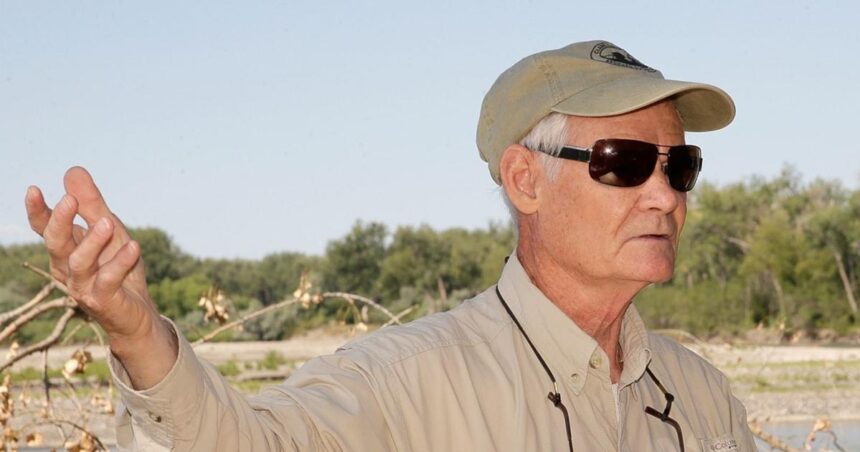It speaks volumes about Ralph Saunders’ meticulousness that he brought a battery-operated razor to shave with during our 2006 backpacking trip in the Beartooth Mountains.
This was my first adventure with the energetic 63-year-old, who seemed remarkably spry for his age. (I am now the same age, which doesn’t feel as old as it did when I was 45.) As he effortlessly climbed the steep hillside from nearby Deep Lake after a day of fishing, I couldn’t help but think he had some mountain goat in his blood.
Ralph Saunders expresses gratitude to a crowd during an award ceremony.
Brett French
Now Saunders is considered a GOAT, one of the Greatest Of All Time.
On August 8th, 2024, he was recognized as the Montana Heritage Keeper. This prestigious award, given by the Montana Historical Society’s board of trustees, acknowledges individuals who demonstrate exceptional commitment and impact in preserving Montana’s historical and cultural heritage for present and future generations.
People are also reading…
In his humble acceptance speech, Saunders focused on how undeserving he felt of the award, diverting attention to the remarkable individuals in attendance. He specifically acknowledged Ross Waples for his work on Native American water rights, MSU Billings history professor Tom Rust for identifying one of William Clark’s 1806 campsites, and his wife and editor Marlene, among others.
“There are many deserving individuals in this room who deserve this award as much or more than I do,” Saunders expressed to the audience at the Western Heritage Center.
Mike Penfold, the volunteer conservation program director for Our Montana, sprays diesel fuel onto a pile of gathered brush during the work day for the new South Billings Boulevard Bridge fishing access site in 2019.
Another GOAT
Saunders’ assessment was accurate. There were other GOATs in attendance, along with some who have since passed, as he mentioned.
For instance, Mike Penfold, the field director of Our Montana, previously a Bureau of Land Management official, has been a key figure in various initiatives, from advocating for wilderness designations in the Upper Missouri River Breaks to preserving the Bozeman Trail.
Like Saunders, Penfold generously shared his knowledge with me during my early days as a reporter. Twenty-four years ago, he invited me on a canoe trip down the Upper Missouri River Breaks Wild and Scenic section, imparting wisdom as we explored side canyons and bluffs over three days.
“These areas represent unique ecological systems absent from designated wilderness areas,” Penfold disclosed during our trip. At the age of 62, he continued to be involved in numerous projects, including assisting in securing land along the Yellowstone River post the ExxonMobil oil pipeline spill settlement, as well as volunteering to remove invasive Russian olive trees after Montana Fish, Wildlife & Parks acquired a new fishing access site by Blue Creek Bridge.
Another prominent figure on my list, recently deceased, was John Gibson, a former Forest Service employee and core member of the Public Land Water Access Association. The group, known for advocating for open access to roads and trails, has played a significant role in addressing access issues in Montana, notwithstanding limited resources and tension with landowners.
Mentors
Saunders also acknowledged two former Billings Gazette colleagues — opinion page editor Gary Svee and outdoor editor Mark Henckel — for their collaboration on a book covering William Clark’s travels through Stillwater County. It was dubbed the smallest book on the smallest part of the Lewis and Clark Trail.
Henckel, who mentored me upon my arrival in Billings 25 years ago, provided me with opportunities to cover stories involving individuals like Saunders and Penfold, while generously sharing his vast knowledge. I particularly enjoyed his insightful, humorous, and self-effacing columns.
Svee supervised my layout design for the opinion pages back when we handled everything in-house. Looking back, those were the glory days of my journalism career, as page design is now outsourced to a regional center located in another state.
Svee’s good-humored anecdotes about his upbringing in Stillwater Valley added a touch of warmth to an otherwise routine job of reviewing and assembling opinion pieces. Alongside his wife Diane, they were among the first to welcome my family to Billings. Truly good-hearted individuals.
Saunders recounted his high school football days with Svee, recalling how the coach paired them together due to Svee’s considerate nature towards his smaller teammate, despite the significant size difference.
Ralph Saunders and Tom Rust reviewing maps in 2013 to study changes in the Yellowstone River’s course over the past 200 years.
Clark’s camp
Rust commenced the praises for Saunders’ efforts in enhancing the public’s historical understanding of the region.
In 2011, Rust sent his Historical Archaeology class to an island in the Yellowstone River, upstream of Park City, for fieldwork. This island was identified by Saunders as the site where William Clark and his expedition camped in 1806 through meticulous research.
Clark, accompanied by Sacajawea and his crew, was leading the return leg of the Corps of Discovery exploration from the Pacific Ocean. In July, the group halted at the site to construct canoes from cottonwood trees.
Prior to Saunders’ discovery, about 15 locations within a 20-mile stretch of the Yellowstone River were proposed as the canoe camp. Saunders’ approach, however, was distinct.
“He conducted incredibly detailed, almost microscopic analysis of the Lewis and Clark journals,” Rust remarked. He and his team eventually confirmed Saunders’ findings by uncovering evidence like a musket ball and remnants of a cook fire from the encampment. Unfortunately, the historic floods of 2022 inundated the island, likely erasing any remaining proof of the ancient journey.
Rust humorously noted that Saunders’ estimation was off by about 250 feet. A remarkable feat considering the site’s age of over 200 years.





